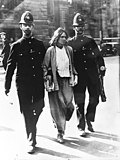Sexism

Sexism is generally defined as discrimination based on the gender of a person—looking down on people because they are male or female.
Overview
Sexism may also include stereotyped roles by gender. International laws, such as the Convention on the Elimination of All Forms of Discrimination against Women or Yogyakarta Principles, demand the end of every form of sexism. Sexism can affect a person attending a party, getting a job, joining a game, trying to get a promotion, being selected and so on. Sexism is often discrimination against women due to the history of sexism in the Western world.
Origin
Sexism was coined[1] by Pauline M. Leet on November 18, 1965.
Misogyny
Misandry
Bias or discrimination against men is called misandry.[2] Misandry's existence is denied by a significant proportion of feminists.[2] Feminists tend to see men as "inherently responsible" for the patriarchy,[2][3] leading many to form the impression that men's suffering has not been given equal attention,[2] while men in Western world are three to four times more likely to die by suicide.[4]
Gendered racism
Gendered racism is a form of oppression that happens due to stereotypes related to race and gender.[5] While many engage in racism to divide others into "superior" and "inferior" to treat them differently, sexism is the prejudice or discrimination based on sex, e.g. bias against women.[5] As a hybrid, gendered racism is related to racial understandings of masculinity and femininity,[5] e.g. bias against women of a certain ethnic group based on their customs. The word was coined by Dutch-Surinamese sociologist Philomena Essed (1955 ‒ ) to refer to women facing racism and sexism at the same time. Essed said,
Racism and sexism intertwine and combine under certain conditions into one hybrid phenomenon.
Those subject to gendered racism often find it hard to know whether others are biased against them because of their race or gender, or both.[5] Nevertheless, both the race and gender of a person is said to intersect to form his or her identity, whose lived experience is suggested to be analyzed based on both their race and gender.[5]
Civil rights movements
The women's rights and men's rights movements both claim to be fighting sexism.
Education
World literacy is lower for women than for men. On October 9, 2012, the Pakistani schoolgirl Malala Yousafzai was shot in the head on her schoolbus by Taliban gunmen because she did activism for girls' rights to education.[6]
Sexism Media
Suffragette organizations campaigned for women's right to vote.
"The Hammer of Witches which destroyeth Witches and their heresy as with a two-edged sword". Title page of the seventh Cologne edition of the Malleus Maleficarum, 1520, from the University of Sydney Library.
Anti-dowry poster in Bangalore, India. According to Amnesty International, "[T]he ongoing reality of dowry-related violence is an example of what can happen when women are treated as property."
Gender pay gap in average gross hourly earnings according to Eurostat 2014
Related pages
References
- ↑ Invent (a new word or phrase). Oxford Languages.
- ↑ 2.0 2.1 2.2 2.3
- Nathanson, Paul; Young, Katherine K. (2006). Legalizing Misandry: From Public Shame to Systemic Discrimination against Men. McGill-Queen's University Press. JSTOR j.ctt80hj2. Retrieved February 11, 2025.
- "Hating men does nothing for women’s liberation". Spiked. September 22, 2020. https://www.spiked-online.com/2020/09/22/hating-men-does-nothing-for-womens-liberation. Retrieved February 11, 2025.
- Wakefield, Mary (November 13, 2021). "The dangerous pleasure of hating men". The Spectator. https://www.spectator.co.uk/article/the-dangerous-pleasure-of-hating-men. Retrieved February 11, 2025.
- Silver, Rebecca (2023). "Misogyny, misandry, sexism and bias in the dental profession and workplace - does it exist?". BDJ Team. 10: 8–11. Retrieved February 11, 2025.
- Barry, John (December 19, 2024). "Misandry, identity politics, and DEI: An interview with Dr Paul Nathanson". The Centre for Male Psychology. Retrieved February 11, 2025.
- ↑ "Debunking the Myth of the Man-Hating Feminist". Psychology Today. March 8, 2024. Retrieved February 11, 2025.
- ↑ Värnik, Peeter (March 2, 2012). "Suicide in the World". International Journal of Environmental Research and Public Health. 9 (3): 760–771. doi:10.3390/ijerph9030760. Retrieved February 11, 2025.
- ↑ 5.0 5.1 5.2 5.3 5.4
- Anderson, M.L., & Collins, P.H. (2004). Race, class, and gender: An anthology (5th ed.) Belmont, CA: Wadsworth/Thompson
- Erving, C.L., Williams, T.R., Frierson, W., & Derisse, M. (2022). Gendered racial microaggressions, psychosocial resources, and depressive symptoms among Black women attending a historically Black university. Society and Mental Health, 12(3), 230–47. https://doi.org/10.1177/21568693221115766
- Essed, P. (1991). Understanding everyday racism: An interdisciplinary theory. Thousand Oaks, CA: Sage.
- Lewis, J., Mendenhall, R., Harwood, S., & Browne Huntt, M. (2013). Coping with Gendered Racial Microaggressions among Black Women College Students. Journal of African American Studies, 17(1), 51–73. doi:10.1007/s12111-012-9219-0
- Thomas, A. J., Witherspoon, K. M., & Speight, S. L. (2008). Gendered racism, psychological distress, and coping styles of African American women. Cultural Diversity and Ethnic Minority Psychology, 14(4), 307.
- Wingfield, A. H. (2007). The modern mammy and the angry black man: African American professionals' experiences with gendered racism in the workplace. Race, Gender & Class, 196–212.
- ↑ Mishal Husain (7 October 2013). "Malala: The girl who was shot for going to school". BBC News Magazine. Retrieved 9 March 2014.






